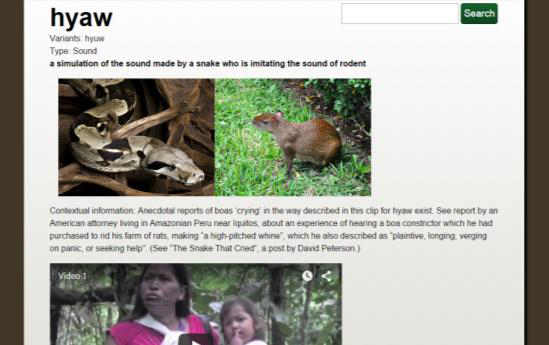Diana Shelton (née Sun) and Janis Nuckolls, Linguistics and English Language
Introduction
Quichua is a branch of Quechua, a group of indigenous South American languages, which is found in Amazonian Ecuador. This language utilizes a type of adverb, called ideophones, which symbolizes sound, motion, and other sensations. Ideophones are often foregrounded with speaker movements and intonation and are therefore difficult to represent in written documentation. Our project aimed to create a video dictionary of Quichua ideophones as a valuable resource for language learners as well as future researchers of ideophones by using various media to demonstrate ideophones’ uses and contexts in reality.
Methodology
We began by collecting video samples and textual definitions of Quichua ideophones. We first obtained 10-15 conversational and narrative video examples of the Quichua language from the Andes and Amazon Field School, Dr. Nuckoll’s research, and student research conducted in Ecuador. We then analyzed each video clip and identified ideophone-gesture composites. We chose 20 of the most salient examples of ideophones and cut each instance into its own 5-10 second clip, stored as YouTube videos on a dedicated YouTube channel in order to reduce the load on our web server. Drawing from Dr. Nuckoll’s book Sounds Like Life1 as well as our own recent observations of the language, we established a cogent textual definition for each ideophone. Secondly, we combined the video and text elements with still images that further demonstrated the context in which the ideophone is used. We stored each ideophone and its corresponding media in an online database. We then discussed user experience for our audiences to create a simple prototype of our website. Next, I coded web pages that integrate the database such that the database populates each webpage with multimedia based on the ideophone selection of the user. This functionality gives our website the ability to load dynamically, rather than having an individual static webpage for each ideophone. Our setup facilitates scalability and long-term maintenance; the project can continue to increase its number of ideophones without much additional attention because new data can be entered into the database and then appear on our website without any changes to the website’s code. I then fleshed out the website with a descriptive home page and search functionality. Finally, we copied our web files from our development site (inaccessible to the public) to our production site (open access), which can be found at quechuarealwords.byu.edu.
Results
Our project resulted in the invention of an active website that artfully and rigorously displays video, image, and textual descriptions of Quichua ideophones. So far, we have been able to develop robust entries for 20 ideophones, five more than our original estimate. Examples of the completed work can be seen in Figure 1 and Figure 2 below.

Figure 1 – The home page of Quechua Real Words uses a site ID, tagline, and small description that efficiently introduces new users to its purpose. The search functionality is prominent and provides an immediate call to action for the user. The page displays an infinitely looping gif that demonstrates the gestures that are so commonly associated with ideophones.

Figure 2 – The web page for the ideophone “hyaw” displays variants of the word, its “type” (discussed below), its textual definition, still images related to the ideophone’s meaning, and videos of its use by native speakers.
Discussion
Our interdisciplinary approach to these linguistic challenges allowed us to not only present previous research in a new and engaging way, but it also led us to further insights on the language. As we considered the best way to represent each ideophone, we worked on creating a typology, or categorization, of related ideophones. Our analysis showed that different types of gestures are associated with different ideophones based on the semantics, or meanings, of the ideophones. For example, rhythmic and abstract movements are commonly paired with ideophones that symbolize sound, while more literal gestures are used with ideophones that indicate motion. The latter of these types are more likely to involve visual cues that show the speaker’s perspective in relation to the event, as well. The architecture of our website has repeatedly transformed to reflect our deeper understanding of ideophones.
Conclusion
The “creative lexicography” demonstrated in this interdisciplinary project has facilitated our ongoing study of ideophone-gesture relationships. Future development of this project will focus on adding new ideophones and media to the website in addition to further user testing. We anticipate the site to be a growing, active collection and are excited to have created the structure to make such growth possible.
